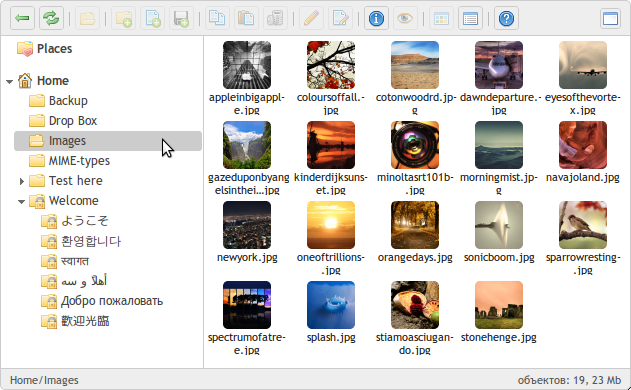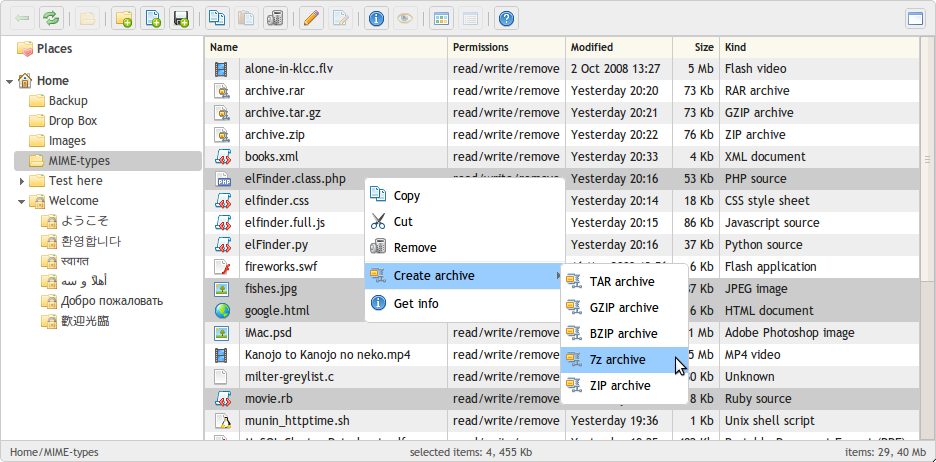开源软件名称:elfinder-2.x-servlet
开源软件地址:https://gitee.com/bluejoe/elfinder-2.x-servlet
开源软件介绍:
English Version: https://github.com/bluejoe2008/elfinder-2.x-servlet/blob/master/README.md what's elfinder-2.x-servletelfinder-2.x-servlet implements a java servlet for elfinder-2.x connector elfinder is an Open-source file manager for web, written in JavaScript using jQuery and jQuery UI.see also http://elfinder.org   for elfinder-1.2 users, please go to https://github.com/Studio-42/elfinder-servlet. importing elfinder-2.x-servletthis project is released as an artifact on the central repostory use <dependency> <groupId>com.github.bluejoe2008</groupId> <artifactId>elfinder-servlet-2</artifactId> <version>1.1</version> <classifier>classes</classifier></dependency> to add dependency in your pom.xml building elfinder-2.x-servletthe source files includes: - src/main/webapp : a normal j2ee application includes elfinder, WEB-INF...
- src/main/java: source codes for elfinder-servlet
- src/main/resources: source codes for elfinder-servlet
To build this project with maven run: to run this project within a jetty container use: using elfinder-2.x-servlet in your web appsjust use following codes to tell elfinder to connect with server-side servlet: <script type="text/javascript" charset="utf-8"> $(document).ready(function() { $('#elfinder').elfinder({ url : 'elfinder-servlet/connector', }); }); </script>in your web.xml, following codes should be added to enable the servlet: <servlet> <servlet-name>elfinder</servlet-name> <servlet-class>org.springframework.web.servlet.DispatcherServlet </servlet-class></servlet><servlet-mapping> <servlet-name>elfinder</servlet-name> <url-pattern>/elfinder-servlet/*</url-pattern></servlet-mapping> yes! elfinder-2.x-servlet is developed upon SpringFramework (http://springframework.org) an example elfinder-servlet.xml configuration is shown below: <!-- find appropriate command executor for given command--><bean id="commandExecutorFactory" class="cn.bluejoe.elfinder.controller.executor.DefaultCommandExecutorFactory"> <property name="classNamePattern" value="cn.bluejoe.elfinder.controller.executors.%sCommandExecutor" /> <property name="map"> <map> <!-- <entry key="tree"> <bean class="cn.bluejoe.elfinder.controller.executors.TreeCommandExecutor" /> </entry> --> </map> </property></bean><!-- FsService is often retrieved from HttpRequest --><!-- while a static FsService is defined here --><bean id="fsServiceFactory" class="cn.bluejoe.elfinder.impl.StaticFsServiceFactory"> <property name="fsService"> <bean class="cn.bluejoe.elfinder.impl.DefaultFsService"> <property name="serviceConfig"> <bean class="cn.bluejoe.elfinder.impl.DefaultFsServiceConfig"> <property name="tmbWidth" value="80" /> </bean> </property> <property name="volumeMap"> <!-- two volumes are mounted here --> <map> <entry key="A"> <bean class="cn.bluejoe.elfinder.localfs.LocalFsVolume"> <property name="name" value="MyFiles" /> <property name="rootDir" value="/tmp/a" /> </bean> </entry> <entry key="B"> <bean class="cn.bluejoe.elfinder.localfs.LocalFsVolume"> <property name="name" value="Shared" /> <property name="rootDir" value="/tmp/b" /> </bean> </entry> </map> </property> <property name="securityChecker"> <bean class="cn.bluejoe.elfinder.impl.FsSecurityCheckerChain"> <property name="filterMappings"> <list> <bean class="cn.bluejoe.elfinder.impl.FsSecurityCheckFilterMapping"> <property name="pattern" value="A_.*" /> <property name="checker"> <bean class="cn.bluejoe.elfinder.impl.FsSecurityCheckForAll"> <property name="readable" value="true" /> <property name="writable" value="true" /> </bean> </property> </bean> <bean class="cn.bluejoe.elfinder.impl.FsSecurityCheckFilterMapping"> <property name="pattern" value="B_.*" /> <property name="checker"> <bean class="cn.bluejoe.elfinder.impl.FsSecurityCheckForAll"> <property name="readable" value="true" /> <property name="writable" value="false" /> </bean> </property> </bean> </list> </property> </bean> </property> </bean> </property></bean> A ConnectorServlet is provided for people who do not use spring framework: <servlet> <servlet-name>elfinder-connector-servlet</servlet-name> <servlet-class>cn.bluejoe.elfinder.servlet.ConnectorServlet </servlet-class></servlet><servlet-mapping> <servlet-name>elfinder-connector-servlet</servlet-name> <url-pattern>/elfinder-servlet/connector</url-pattern></servlet-mapping> If you want to customize behavior of ConnectorServlet(see https://github.com/bluejoe2008/elfinder-2.x-servlet/blob/0.9/src/main/java/cn/bluejoe/elfinder/servlet/ConnectorServlet.java), you may need to create a derivided servlet class based on ConnectorServlet. features- easy to use: just define a servlet in your web.xml, or configure the XML file in spring IOC format, and then start your web application
- easy to import: an artifact on the central repostory is provided, use maven to manage the dependency
- logic file views: a local file system is not necessary, you can define your FsService
- easy to personalize: different file views are allowed for different users, just provide a custom FsServiceFactory
- easy to modify and extend: provide your own CommandExecutors to respond new commands
Command, CommandExecutor, CommandExecutorManagerelfinder-2.x-servlet implements file management commands including: - DIM
- DUPLICATE
- FILE
- GET
- LS
- MKDIR
- MKFILE
- OPEN
- PARENT
- PASTE
- PUT
- RENAME
- RM
- SEARCH
- SIZE
- TMB
- TREE
- UPLOAD(CHUNK supported!!!)
Each command corresponds to a CommandExecutor class, for example, the TREE command is implemented by the class TreeCommandExecutor(see https://github.com/bluejoe2008/elfinder-2.x-servlet/src/main/java/cn/bluejoe/elfinder/controller/executors/TreeCommandExecutor.java). Users can modify existing class or entend new executor class by following this naming rule. Furthermore, this rule can even be modified via setting the commandExecutorFactory in elfinder-servlet.xml, in which default factory is DefaultCommandExecutorFactory(see https://github.com/bluejoe2008/elfinder-2.x-servlet/src/main/java/cn/bluejoe/elfinder/controller/executor/DefaultCommandExecutorFactory.java). A CommandExecutorFactory tells how to locate the command executor(TreeCommandExecutor as an example) by a given command name("TREE" as an example), it is designed as an interface: public interface CommandExecutorFactory{ CommandExecutor get(String commandName);}FsItem, FsVolume, FsService, FsServiceFactoryEach file is represented as a FsItem. And the root of a file is represented as a FsVolume. A FsVolume tells parent-children relations between all FsItems and implements all file operation (for example, create/delete). A FsService may have many FsVolumes. Users can create a FsService via a FsServiceFactory: public interface FsServiceFactory{ FsService getFileService(HttpServletRequest request, ServletContext servletContext);}A simple (and stupid) StaticFsServiceFactory is provided in https://github.com/bluejoe2008/elfinder-2.x-servlet/src/main/java/cn/bluejoe/elfinder/impl/StaticFsServiceFactory.java, which always returns a fixed FsService, despite of whatever it is requested. However, sometimes a FsService should be constructed dynamically according to current Web request. For example, users may own separated file spaces in a network disk service platform, in this case, getFileService() get user principal from current request and offers him/her different file view. Making a releaseFor a developer to make a release they need to have setup an account and with Sonatype and have a PGP keyfor signing the release more details can be found at: http://central.sonatype.org/pages/apache-maven.html Then to make a release you first tag the version and push this to github: mvn release:clean release:prepare and if everything goes ok you can then release the actual artifact based on the tag: This will stage the artifacy on the Sonatype servers, once there it will be checked and it it's ok you canthen release it: http://central.sonatype.org/pages/releasing-the-deployment.html  |
 客服电话
客服电话
 APP下载
APP下载

 官方微信
官方微信

















请发表评论